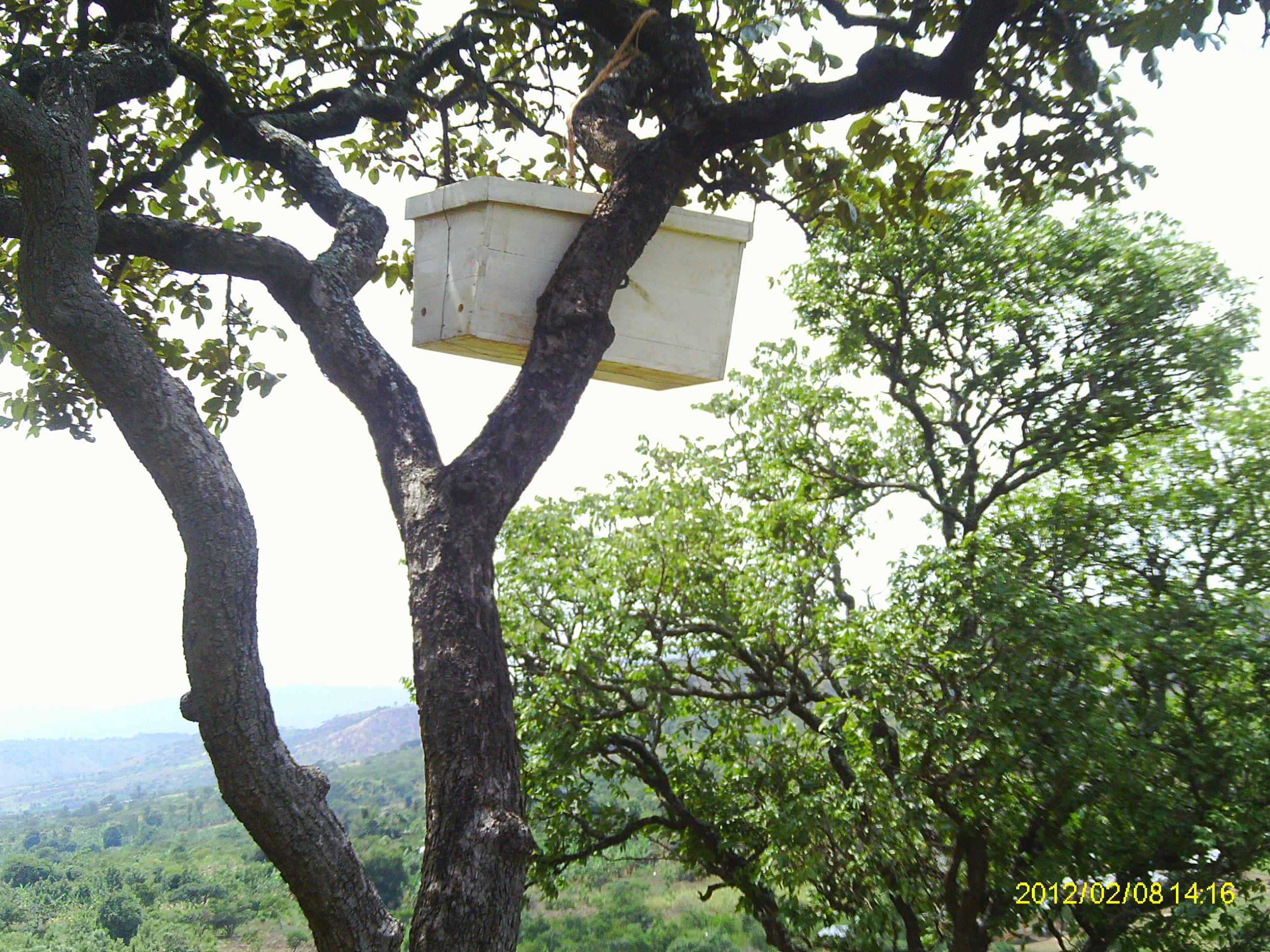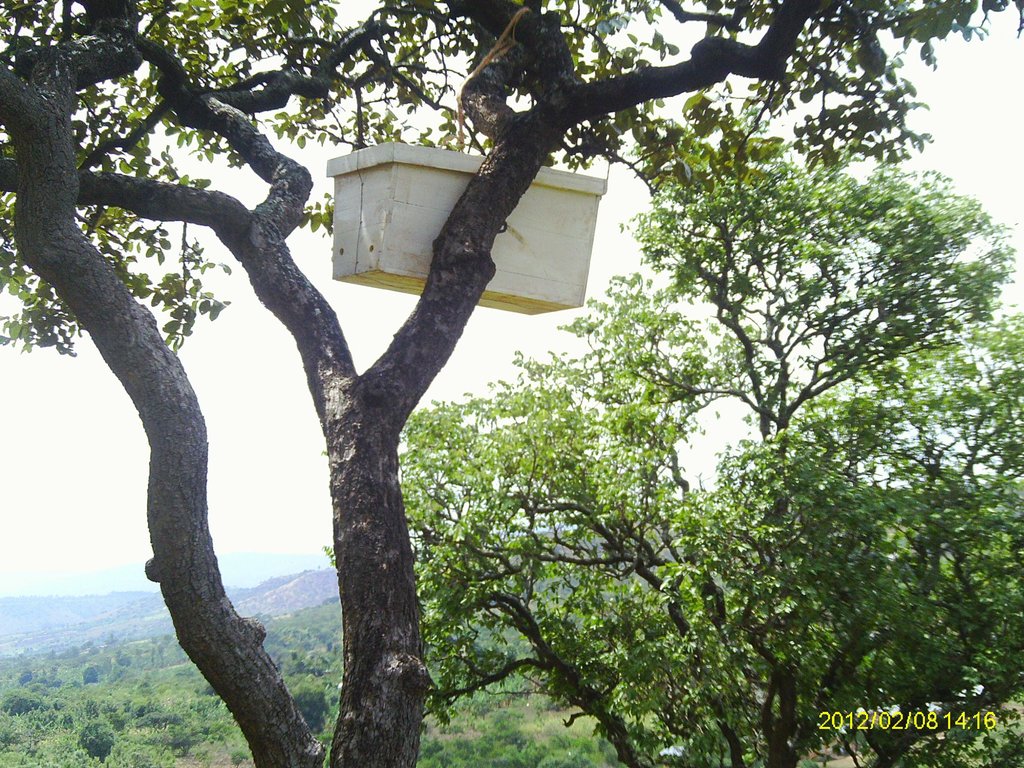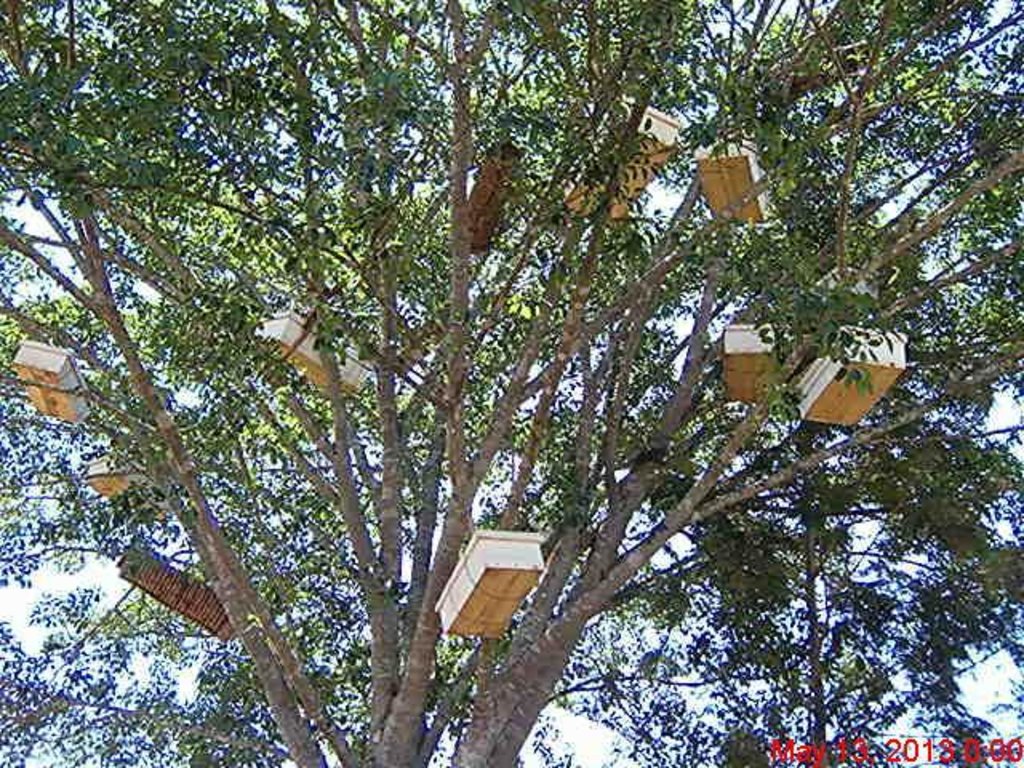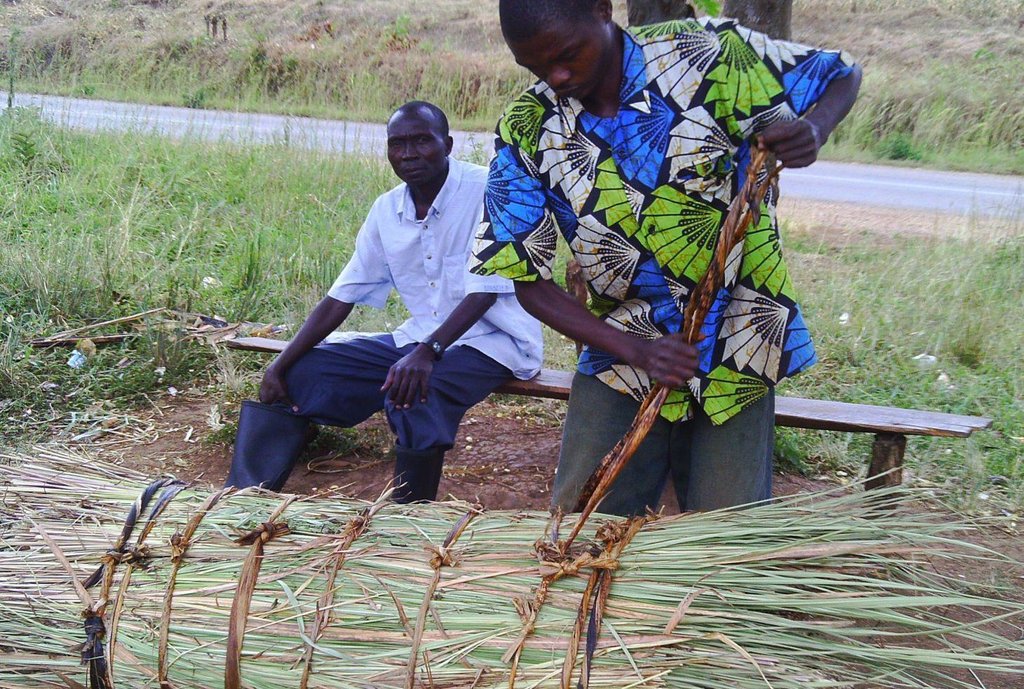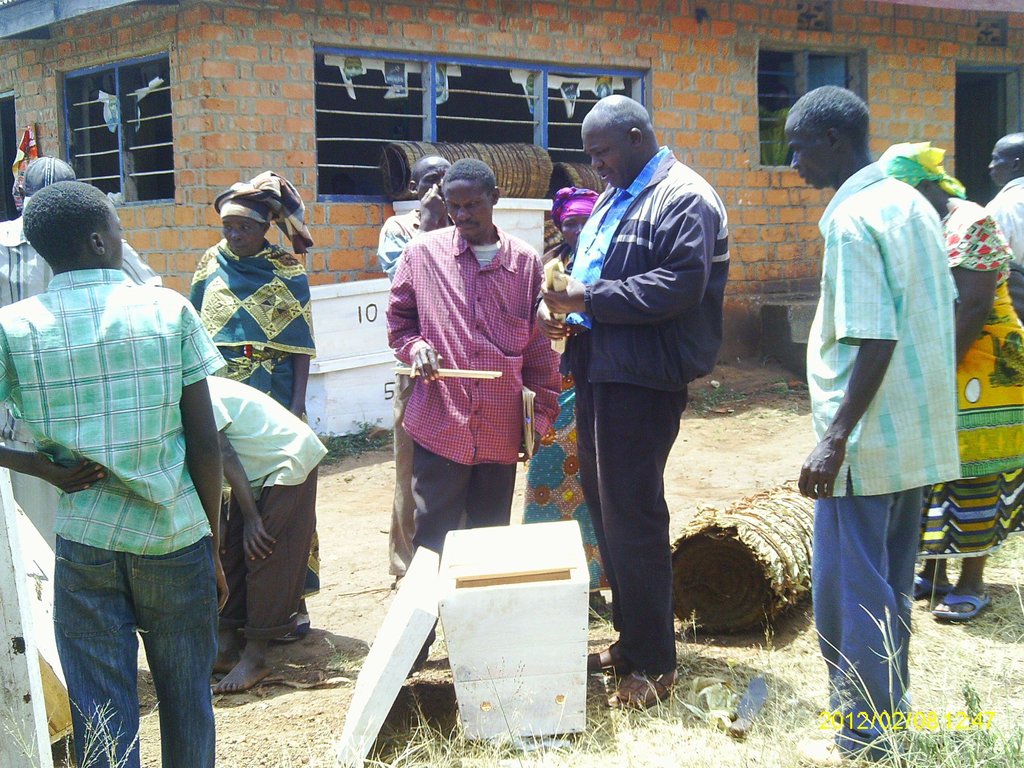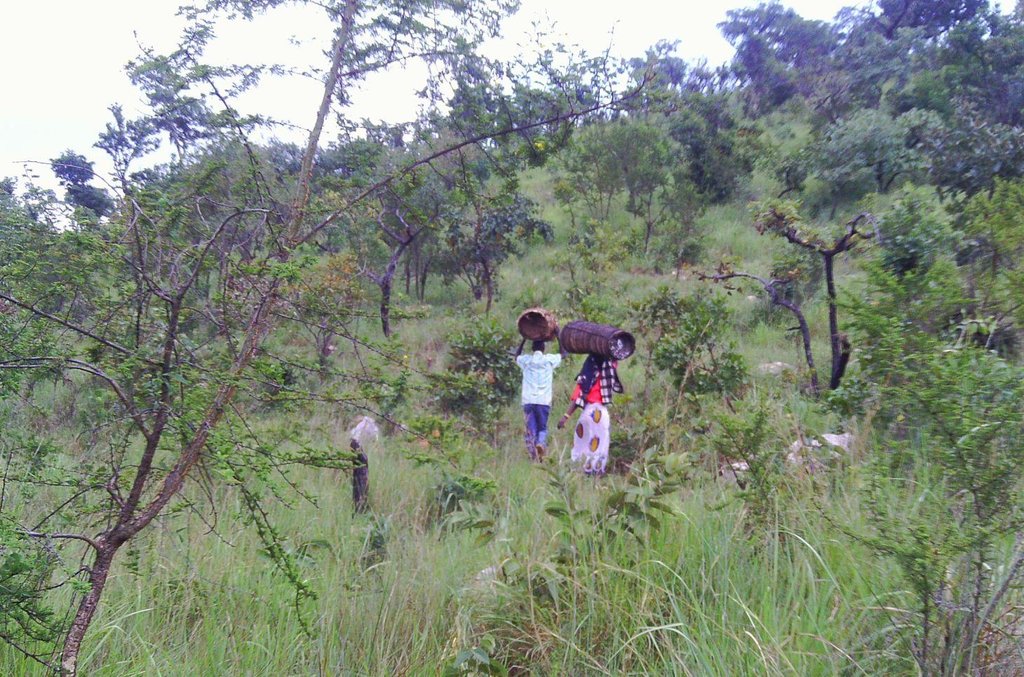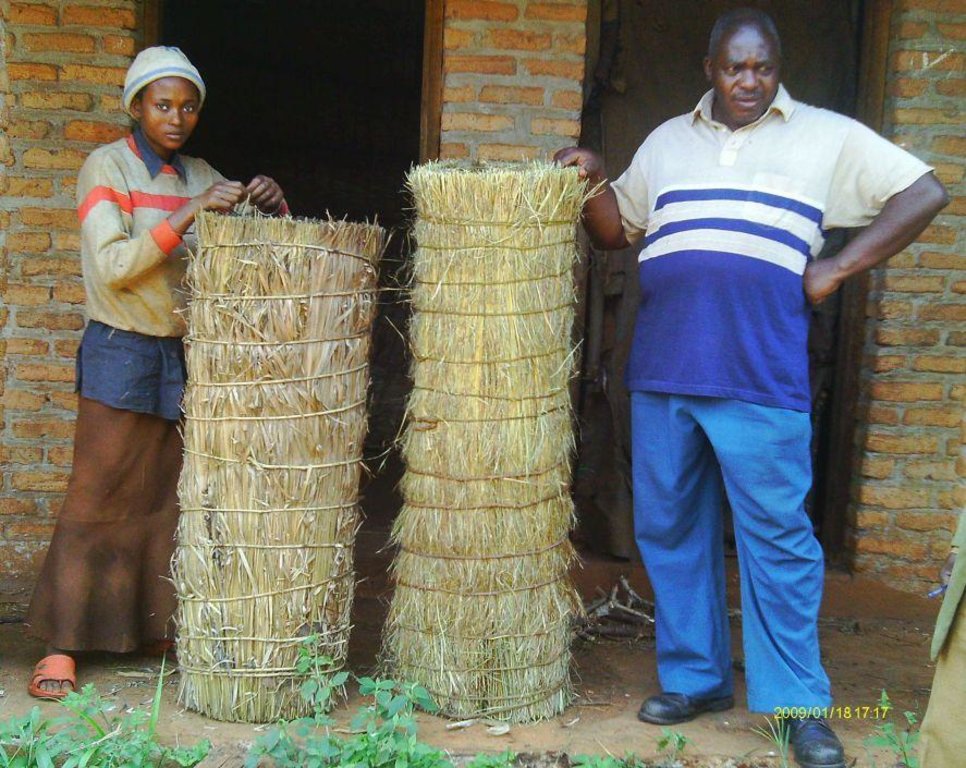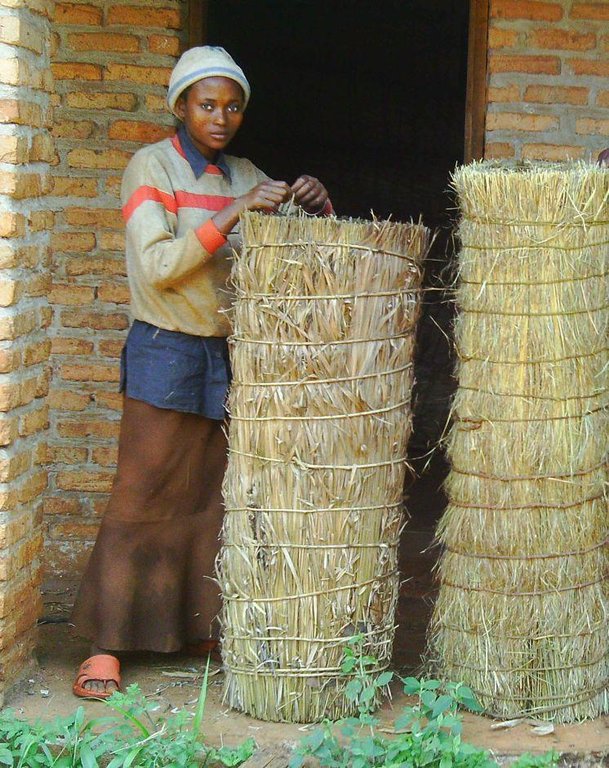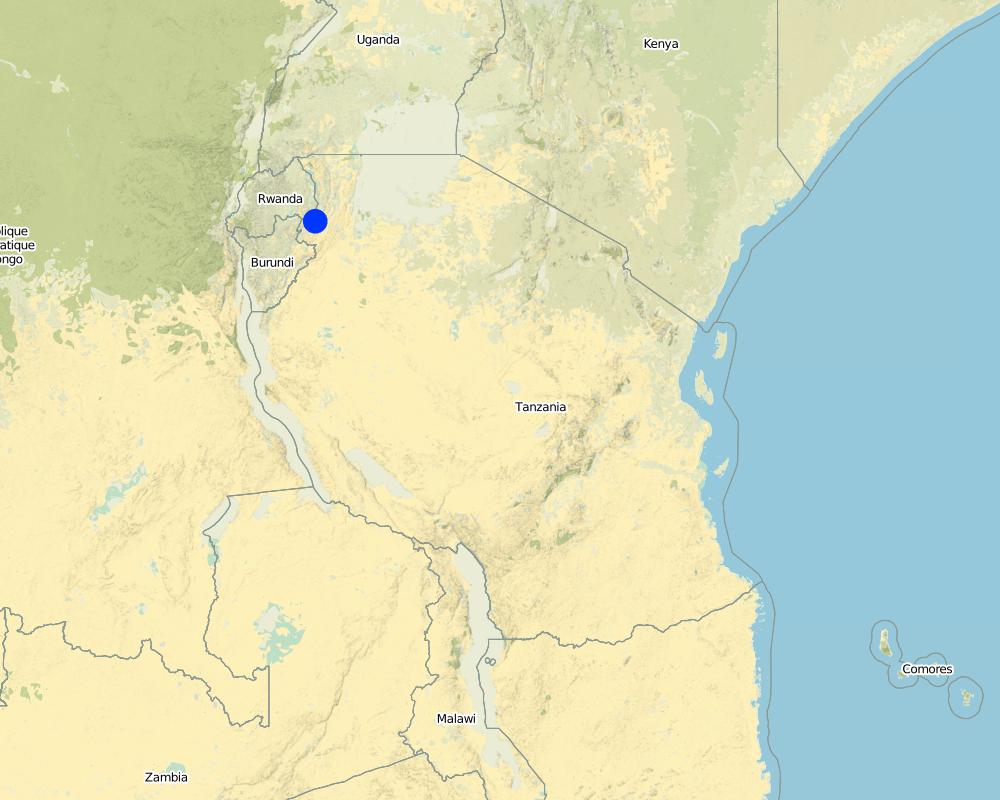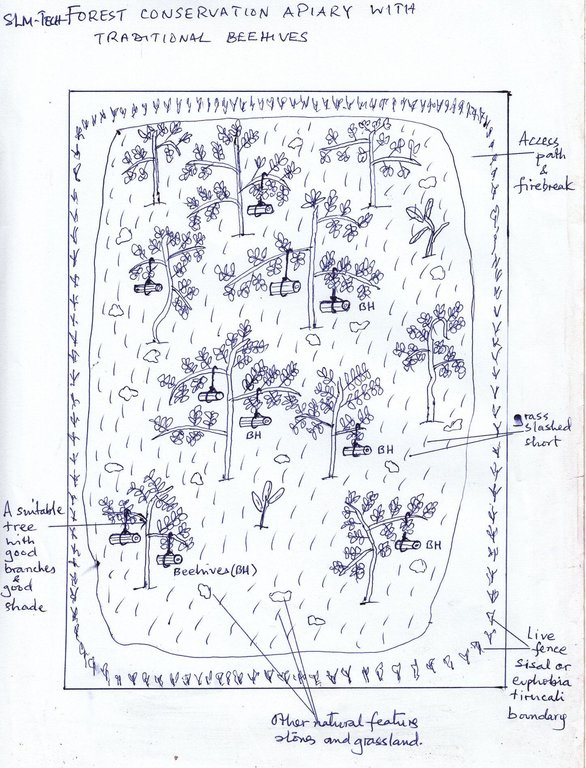Natural forest conservation using apiaries [ຕານຊາເນຍ]
- ການສ້າງ:
- ປັບປູງ:
- ຜູ້ສັງລວມຂໍ້ມູນ: Philip Ileta
- ບັນນາທິການ: –
- ຜູ້ທົບທວນຄືນ: David Streiff, Alexandra Gavilano
Utunzaji misitu kwa kufuga nyuki (swahili),
technologies_1152 - ຕານຊາເນຍ
ເບິ່ງພາກສ່ວນ
ຂະຫຍາຍທັງໝົດ ຍຸບທັງໝົດ1. ຂໍ້ມູນທົ່ວໄປ
1.2 ຂໍ້ມູນ ການຕິດຕໍ່ພົວພັນ ຂອງບຸກຄົນທີ່ສໍາຄັນ ແລະ ສະຖາບັນ ທີ່ມີສ່ວນຮ່ວມ ໃນການປະເມີນເອກກະສານ ເຕັກໂນໂລຢີ
ຜຸ້ຊ່ຽວຊານ ດ້ານການຄຸ້ມຄອງ ທີ່ດິນແບບຍືນຍົງ:
Government:
Waluce Michael
Ngara District Council
ຕານຊາເນຍ
Government:
Mugishagwe Wilson
Ngara District Council
ຕານຊາເນຍ
Government:
Sangatati Josephat
Ngara District Council
ຕານຊາເນຍ
ຜຸ້ຊ່ຽວຊານ ດ້ານການຄຸ້ມຄອງ ທີ່ດິນແບບຍືນຍົງ:
Kaihura Fidelis
K-TAMP
ຕານຊາເນຍ
ຊື່ໂຄງການ ທີ່ອໍານວຍຄວາມສະດວກ ໃນການສ້າງເອກກະສານ/ປະເມີນ ເຕັກໂນໂລຢີ (ຖ້າກ່ຽວຂ້ອງ)
The Transboundary Agro-ecosystem Management Project for the Kagera River Basin (GEF-FAO / Kagera TAMP )ຊື່ສະຖາບັນ (ຫຼາຍສະຖາບັນ) ທີ່ອໍານວຍຄວາມສະດວກ ໃນການສ້າງເອກກະສານ / ປະເມີນ ເຕັກໂນໂລຢີ (ຖ້າກ່ຽວຂ້ອງ)
Food and Agriculture Organization of the United Nations (FAO) - ອີຕາລີຊື່ສະຖາບັນ (ຫຼາຍສະຖາບັນ) ທີ່ອໍານວຍຄວາມສະດວກ ໃນການສ້າງເອກກະສານ / ປະເມີນ ເຕັກໂນໂລຢີ (ຖ້າກ່ຽວຂ້ອງ)
Ngara District Council (Ngara District Council) - ຕານຊາເນຍ1.3 ເງື່ອນໄຂ ກ່ຽວກັບ ການນໍາໃຊ້ຂໍ້ມູນເອກະສານ ທີ່ສ້າງຂື້ນ ໂດຍຜ່ານ ອົງການພາບລວມຂອງໂລກ ທາງດ້ານແນວທາງ ແລະ ເຕັກໂນໂລຢີ ຂອງການອານຸລັກ ທໍາມະຊາດ (WOCAT)
ຜູ້ປ້ອນຂໍ້ມູນ ແລະ ບຸກຄົນສຳຄັນ ທີ່ໃຫ້ຂໍ້ມູນ (ຫຼາຍ) ຍິນຍອມ ຕາມເງື່ອນໄຂ ໃນການນຳໃຊ້ຂໍ້ມູນ ເພື່ອສ້າງເປັນເອກກະສານຂອງ WOCAT:
ແມ່ນ
1.5 ແບບສອບຖາມທີ່ອ້າງອີງເຖີງແນວທາງ ການຄຸ້ມຄອງທີ່ດິນແບບຍືນຍົງ (ໄດ້ເຮັດເປັນເອກະສານທີ່ໃຊ້ WOCAT)
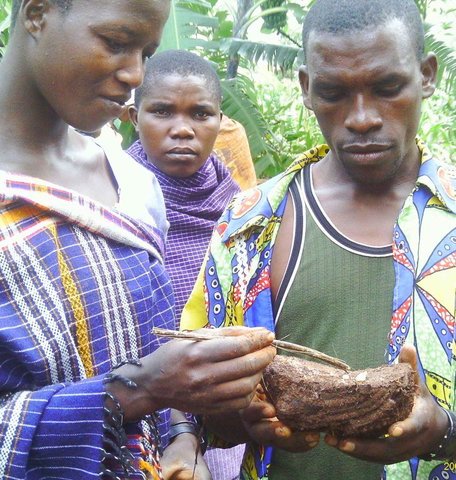
Community intergrated catchment ecosystem management [ຕານຊາເນຍ]
Adaptive Agro-ecosystem Micro-catchment Approach.
- ຜູ້ສັງລວມຂໍ້ມູນ: ALLAN BUBELWA
2. ການອະທິບາຍ ເຕັກໂນໂລຢີ ຂອງການຄຸ້ມຄອງ ທີ່ດິນແບບຍືນຍົງ
2.1 ຄໍາອະທິບາຍສັ້ນຂອງ ເຕັກໂນໂລຢີ
ການກຳໜົດຄວາມໝາຍ ຂອງເຕັກໂນໂລຢີ:
Establishment of apiaries in natural forests to retard forest mismanagement and improve honey production
2.2 ການອະທິບາຍ ລາຍລະອຽດ ຂອງເຕັກໂນໂລຢີ
ການພັນລະນາ:
This technology has been practiced in Ngara region for the last 50 year and involves construction and upkeep of apiaries for honey and related goods production. The apiaries are constructed by farmers (traditional) or purchased (modern box hieves) and then positioned in a designated forest area that is away from settlements and public places. The apiaries should be hanged on a strong branches of trees with good shade and the honey production process takes from 9 to 12 months.
Purpose of the Technology: It is recommended to apply this technology in the forest that is exposed to deforestation as apiaries help to enhance forest protection. The establishment of apiaries help to improve management of the natural forest while increasing production of honey. This will contribute to the better livelihood of the community and environmental wellbeing.
Establishment / maintenance activities and inputs: The described technology covers area of enclosed 4 hectares of natural forest and establishment of 365 apiaries (338 traditional, 27 box hives); the group of practitioners consist of 10 members (7 male and 3 female). The establishment procedures require: a) identification of forest at risk of degradation, b) ermarcation of the apiary forest, c) creefing of fire breaks d) reparations for and hanging the beehives (traditional and box hives). Maintanance acivities include a) regular slashing of grasses and bushes around the trees with hives b)grading with hand hoes the fire breaks/ roads around the entire forest for fire protection before each dry season c) cleaning of hives,repairs and harvest honey with bee protectives (bee smoker,bee veils,gloves) to eliminate the risks of fire in the forest.Patrol and guard tresspassers d) monitoring pests and diseases
Natural / human environment: Natural occuring tree species include: Combretus spp., Albizia spp., Parinari spp., Pericopsis spp. and Eucalyptus woodlots. Grazing areas are nearby but restricted by village by laws to tress pass in the forest apiary
The aipiaries should be located near permanent water sources because bees use water for honey production and cooling in the hives. Farmers with bee hives become more committed to protect their forest when they hang beehives in the area. Honey is harvested for consumption, trade and medicinal mixtures
The land users are small scale subsistance farmers with poor to average income/wealth,organised as a group of 10 farmers. the population density is between 200-500 people per square km and anual population growth at 2-3% Land ownership is both individual and communal but there are natural forestl areas owned communally through village governments where groups may access temporarily by request to establish environmental friendly activities such as forest apiaries.
2.3 ຮູບພາບຂອງເຕັກໂນໂລຢີ
2.5 ປະເທດ / ເຂດ / ສະຖານທີ່ບ່ອນທີ່ ເຕັກໂນໂລຢີ ໄດ້ຮັບການນໍາໃຊ້ ແລະ ທີ່ຖືກປົກຄຸມດ້ວຍການປະເມີນຜົນ
ປະເທດ:
ຕານຊາເນຍ
ພາກພື້ນ / ລັດ / ແຂວງ:
Tanzania
ຂໍ້ມູນເພີ່ມເຕີມຂອງສະຖານທີ່:
Ngara District
ໃຫ້ລະບຸ ການແຜ່ຂະຫຍາຍ ເຕັກໂນໂລຢີ:
- ແຜ່ຂະຫຍາຍຢ່າງໄວວາໃນພື້ນທີ່
ຖ້າຫາກບໍ່ຮູ້ເນື້ອທີ່ທີ່ແນ່ນອນ, ໃຫ້ລະບຸ ເນື້ອທີ່ໂດຍປະມານ ທີ່ໃກ້ຄຽງ:
- < 0.1 ກິໂລແມັດ2 (10 ເຮັກຕາ)
ຄວາມຄິດເຫັນ:
The described technology covers area of enclosed 4 hectares of natural forest. Applied 365 bee hives (338 traditional, 27 box hives); the practitioners group has 10 members (7male and 3 female)
Map
×2.6 ວັນທີໃນການຈັດຕັ້ງປະຕິບັດ
ຖ້າຫາກວ່າ ບໍ່ຮູ້ຈັກ ປີທີ່ຊັດເຈນ ແມ່ນໃຫ້ປະມານ ວັນທີເອົາ:
- ຫຼາຍກ່ອນ 50 ປີຜ່ານມາ (ແບບພື້ນບ້ານ)
2.7 ການນໍາສະເໜີ ເຕັກໂນໂລຢີ
ໃຫ້ລະບຸ ເຕັກໂນໂລຢີ ໄດ້ຖືກຈັດຕັ້ງປະຕິບັດຄືແນວໃດ?
- ເປັນສ່ວນໜື່ງຂອງລະບົບພື້ນເມືອງ (>50 ປີ)
ຄວາມຄິດເຫັນ (ປະເພດ ໂຄງການ ແລະ ອື່ນໆ):
Beekeeping using local hives is a tradtional practice among the the Hangaza and Shubi ethinic tribes of Ngara district
3. ການໃຈ້ແຍກ ເຕັກໂນໂລຢີ ໃນການຄຸ້ມຄອງ ດິນແບບຍືນຍົງ
3.1 ຈຸດປະສົງຫຼັກ (ຫຼາຍ) ຂອງເຕັກໂນໂລຢີ
- ປົກປັກຮັກສານໍ້າ / ນໍ້າພື້ນທີ່ - ປະສົມປະສານກັບ ເຕັກໂນໂລຢີອື່ນໆ
- ປົກປັກຮັກສາ / ການປັບປຸງຊີວະນາໆພັນ
3.2 ປະເພດການນໍາໃຊ້ທີ່ດິນ ໃນປະຈຸບັນ() ທີ່ເຕັກໂນໂລຢີ ໄດ້ຖືກນໍາໃຊ້

ປ່າໄມ້ / ປ່າ
- Combretus spp., Albizia spp., Parinari spp., Pericopsis spp. and Eucalyptus woodlots
ຜົນຜະລິດ ແລະ ການບໍລິການ:
- ໄມ້ຟືນ
- ຜະລິດຕະພັນ ປ່າໄມ້ອື່ນໆ
- ທົ່ງຫຍ້າ
- ການອະນຸລັກທໍາມະຊາດ / ການປ້ອງກັນ
ຄວາມຄິດເຫັນ:
Major land use problems (compiler’s opinion): Deforestation and fire burning during dry season
Reduction of biodiversity
Major land use problems (land users’ perception): Droughts and vegetation burning during dry seasons
Problems / comments regarding forest use: the natural forest has been set aside for establishing bee apiaries therefore only forest managenet operation are conducted(slashing of grass)
3.4 ການສະໜອງນ້ຳ
ຄວາມຄິດເຫັນ:
Number of growing seasons per year:
2
Specify:
Longest growing period in days: 120; Longest growing period from month to month: Sept-December; Second longest growing period in days: 90; Second longest growing period from month to month: March to May
3.5 ການນໍາໃຊ້ເຕັກໂນໂລຢີ ທີ່ຢູ່ໃນກຸ່ມການຄຸ້ມຄອງ ທີ່ດິນແບບຍືນຍົງ
- ການປິດພື້ນທີ່ (ຢຸດການນໍາໃຊ້, ເພື່ອປູກເປັນປ່າຟື້ນຟູ)
- ການລ້ຽງເຜີ້ງ, ສັດນໍ້າ, ສັດປີກ, ກະຕ່າຍ, ມ້ອນໃໝ ແລະ ອື່ນໆ.
3.6 ມາດຕະການ ການຄຸ້ມຄອງ ທີ່ດິນແບບຍືນຍົງ ປະກອບດ້ວຍ ເຕັກໂນໂລຢີ

ມາດຕະການ ທາງການກະສິກໍາ
- A7: ອື່ນໆ

ມາດຕະການ ທາງດ້ານການຄຸ້ມຄອງ
- M3: ອີງຕາມສະພາບແວດລ້ອມ ທາງທຳມະຊາດ ແລະ ມະນຸດ
3.7 ປະເພດດິນເຊື່ອມໂຊມ ຫຼັກທີ່ໄດ້ນໍາໃຊ້ ເຕັກໂນໂລຢີ

ການເຊື່ອມໂຊມ ທາງຊີວະພາບ
- Bc: ການຫຼຸດຜ່ອນການປົກຫຸ້ມຂອງພືດ
- Bh: ການສູນເສຍ ທີ່ຢູ່ອາໃສ ຂອງສິ່ງທີ່ມີຊິວິດ
- Bq: ປະລິມານ / ອິນຊີວັດຖຸຫຼຸດລົງ
- Bf: ຜົນກະທົບ ຄວາມເສຍຫາຍ ຈາກໄຟໄໝ້
- Bs: ຄຸນນະພາບ / ການອັດແໜ້ນ ຂອງສາຍພັນຫຼຸດລົງ
ຄວາມຄິດເຫັນ:
Main type of degradation addressed: Bc: reduction of vegetation cover, Bh: loss of habitats, Bq: quantity / biomass decline, Bf: detrimental effects of fires, Bs: quality and species composition /diversity decline
Main causes of degradation: deforestation / removal of natural vegetation (incl. forest fires) (Deforestation through cutting of trees), over-exploitation of vegetation for domestic use (Mainly for firewood), industrial activities and mining (Firewood for burning bricks made from clay), droughts, land tenure (Lack of village land use plans for the area), governance / institutional (Weak natural resources enforcent institution at village level)
Secondary causes of degradation: overgrazing
3.8 ການປ້ອງກັນ, ການຫຼຸດຜ່ອນ, ຫຼືການຟື້ນຟູຂອງການເຊື່ອມໂຊມຂອງດິນ
ໃຫ້ລະບຸ ເປົ້າໝາຍ ເຕັກໂນໂລຢີ ທີ່ພົວພັນ ກັບຄວາມເຊື່ອມໂຊມຂອງດິນ:
- ປ້ອງກັນການເຊື່ອມໂຊມຂອງດິນ
- ຫຼຸດຜ່ອນການເຊື່ອມໂຊມຂອງດິນ
ຄວາມຄິດເຫັນ:
Secondary goals: mitigation / reduction of land degradation
4. ຂໍ້ກໍາໜົດ, ກິດຈະກໍາການປະຕິບັດ, ວັດຖຸດິບ, ແລະຄ່າໃຊ້ຈ່າຍ
4.1 ເຕັກນິກ ໃນການແຕ້ມແຜນວາດ ເຕັກໂນໂລຢີ
ຄຸນລັກສະນະ ຂອງເຕັກນິກ (ທີ່ກ່ຽວຂ້ອງ ກັບການແຕ້ມແຜນວາດ ທາງດ້ານເຕັກນີກ):
Layout of natural apriaries (beehives BH) placed on the trees (good braches with shade), access path and firebreak and live fence.
Ngara district Council
Date: 15 May 2012
Technical knowledge required for field staff / advisors: moderate (To extend knowledge/skills on modern/sustainable beekeeping)
Technical knowledge required for land users: moderate (To add/improve skills on existing indigineous knowledge)
Main technical functions: indirectly minimize deforestation, indirectly increase of biomass
Secondary technical functions: promotion of vegetation species and varieties (quality, eg palatable fodder), control of fires, reduction of dry material (fuel for wildfires), spatial arrangement and diversification of land use
Aligned: -along boundary
Vegetative material: O : other
Change of land use practices / intensity level: Establishment of bee apiaries in forest to add on value/productivity and optimise diversification of land use
Layout change according to natural and human environment: The site should be away at least 400m from nearby settlements/public places
Major change in timing of activities: Twice per year Feb and Sept during honey harvesting season management activities are at their peak.
- Fire breaks established in June /July before dry season commence
Control / change of species composition: Various flora and fauna organisms get time to establish and grow well due to absence of burning
ຜູ້ຂຽນ:
Ileta Philip, P.O BOX 30, Ngara
4.2 ຂໍ້ມູນທົ່ວໄປກ່ຽວກັບການຄິດໄລ່ປັດໃຈຂາເຂົ້າໃນການຜະລິດ ແລະ ມູນຄ່າອື່ນໆ
ລະບຸ ສະກຸນເງິນທີ່ໃຊ້ສໍາລັບ ການຄິດໄລ່ຄ່າໃຊ້ຈ່າຍ:
- USA
ລະບຸ ຄ່າຈ້າງ ຄ່າແຮງງານສະເລ່ຍ ຕໍ່ ວັນ:
1.25
4.3 ການສ້າງຕັ້ງກິດຈະກໍາ
| ກິດຈະກໍາ | Timing (season) | |
|---|---|---|
| 1. | Purchase of hives and binding wires | Before dry season |
| 2. | Purchase of beekeeping protectives | Routine |
| 3. | Slashing, screefing bushes and tall grasses; planting hedge around forest boundary | Before dry season |
| 4. | Baiting and hanging apiaries | Before dry season |
| 5. | Purhase of cuttings (euphobia spp) | wet season |
ຄວາມຄິດເຫັນ:
FOREST CONSERVATION APIARIES technology REVISED PART-November 2013 Description and purpose This is a practice where farmers hang bee hives on branches of trees in the forest and keep the honey bees between six to twelve months whereby honey is already mature for harvesting. Conventional beekeeping methods have introduced other practices such as placing beehives on stands/platforms and keeping many hives in the shelter bee houses whereby honey production can be increased. The trees and forest where bee hives are hanged are normally respected and not felled indiscriminately.
Identification of suitable trees/forest Bees forage on nectar and pollen from flowers of many trees, herbs, shrubs and field plants. However there are specific plant species which are more preferred were bees visit more frequently. The forest or locality with rich biodiversity of the suitable trees/plants is conducive for establishment of a bee apiary. Prominent tree species in this zone include Parinari curatelifolia, Combretum spp, Brachtegia spp, Albizia spp, Acacia spp and cultivated crops such as banana, coffee, and annual crops which include maize, bean and sorghum The source of permanent water should be nearby preferably not more than 3kms because bees use much water in feeding, making honey and to perform cooling in the hives. Demarcation of the apiary forest It is usual for the beekeepers to demarcate the areas so as to inform and alert the community members the existence of the beehives. The demarcation signs may involve partially debarking part of the stem bark of the border trees. The use of colour paints, planting of hedge rows and other boundary marker plants are increasingly becoming popular around many forest apiaries. The common plants for live fence include Euphorbia tirucali, Agaves sisalana and Dovyalis caffra. Types of bee hives Common traditional beehives involve log hives, small poles/withies hives, straw hives, calabashes and clay pots. The use of modern box hives has increased in recent years mainly due to development projects support in modern beekeeping methods. Local hives are cheap but not durable limited to one to three years lifespan and the production is low compared with box hives which may last for ten or more years under good care. Preparations for hanging the beehives i) Bait materials Farmers utilize some materials to attract bee colonies establish in the hives. These include smoking or burning of dry honey combs and rubbing of beeswax inside the hives. Other methods involve sprinkling of either maize flour, cassava flour, raw honey or sugar. The use of many types of herbs and other less known substances(less revealed) to rub and smoke in the beehives before hanging is observed to be more effective in some communities. Some traditional beekeepers have become popular and earn money and respect through providing such services .The swarming periods which normally happen in January/Feb and Mid August/ Sept are suitable for hanging the beehives because it may not take long time to pocess the bee colonies ii) Ropes and tree climbing devices The hives has to be carried to the apiary and be hanged up on a tree branch. This may involve transporting the beehives using any transport means and carry on head load for some distance depending on accessibility and the location of the forest apiary. One or two person has to climb the tree and others remain on the ground to lift the hive. The hive is round bound with strong tree bark ropes before hanging The use of sisal ropes and binding wires have replaced the traditional methods to tie and fix the hives in modern beekeeping apiaries. A tall ladder may be helpful to assist in climbing of tall trees in case of aged individuals. The bee shelter house/huts and hive stands These are normally located in the forest apiary and constructed with local materials especially tree poles, straws and thatched on top roof with dry grass or other leafy vegetation such as banana, coconut and many others plants depending on availability. The hut walls are left open without covering the round walls with earth to facilitate cooling with the fresh air movements. The bee hives are placed on top of each other on the 1.2 m high erected tree poles stands. This practice enables to have many bee hives in one house which are easy to manage and protect provided the surrounding flora has good potential of bee forage plants. Water and sugars may be provided in special containers as extra feeds during bad weather conditions
4.4 ຕົ້ນທຶນ ແລະ ປັດໄຈຂາເຂົ້າທີ່ຈໍາເປັນໃນຈັດຕັ້ງປະຕິບັດ
| ລະບຸ ປັດໃຈ ນໍາເຂົ້າ ໃນການຜະລີດ | ຫົວໜ່ວຍ | ປະລິມານ | ຕົ້ນທຶນ ຕໍ່ຫົວໜ່ວຍ | ຕົ້ນທຶນທັງໝົດ ຂອງປັດໃຈຂາເຂົ້າ ໃນການຜະລິດ | % ຂອງຕົ້ນທຶນທັງໝົດ ທີ່ຜູ້ນໍາໃຊ້ທີ່ດິນ ໃຊ້ຈ່າຍເອງ | |
|---|---|---|---|---|---|---|
| ແຮງງານ | Slashing, screefing bushes and tall grasses | persons/day | 100.0 | 0.63 | 63.0 | 100.0 |
| ແຮງງານ | Baiting and hanging apiaries | persons/day | 100.0 | 0.63 | 63.0 | 100.0 |
| ອຸປະກອນ | Hives and binding wires | pieces | 400.0 | 2.25 | 900.0 | 50.0 |
| ອຸປະກອນ | Beekeeping protectives | sets | 4.0 | 93.75 | 375.0 | 80.0 |
| ວັດສະດຸໃນການປູກ | Cuttings | bundles | 200.0 | 0.3 | 60.0 | 100.0 |
| ຕົ້ນທຶນທັງໝົດ ໃນການຈັດຕັ້ງປະຕິບັດ ເຕັກໂນໂລຢີ | 1461.0 | |||||
| ຄ່າໃຊ້ຈ່າຍທັງໝົດ ສຳລັບການສ້າງຕັ້ງເຕັກໂນໂລຢີ ເປັນສະກຸນເງີນໂດລາ | 1461.0 | |||||
ຄວາມຄິດເຫັນ:
Duration of establishment phase: 2 month(s)
4.5 ບໍາລຸງຮັກສາ / ແຜນຈັດຕັ້ງປະຕິບັດ ກິດຈະກໍາ
| ກິດຈະກໍາ | ໄລຍະເວລາ / ຄວາມຖີ່ | |
|---|---|---|
| 1. | Slashing grasss,bushes and firebreaks | Before dry season |
| 2. | Apiaries repair | Regular |
| 3. | Monitoring of bee pests and diseases | Regular |
ຄວາມຄິດເຫັນ:
Bush fire control This is done before the onset of the dry season by establishment of firebreaks around the apiary and slashing short the tall grass and other unwanted vegetation in the apiary forest. Cleaning, repairng and fixing the beehives The beehives that have become loose ,damaged or fallen due to strong winds, rains and disturbance by intruders or animals and birds requires replacement or renovations. In many cases pests such as ants, termites and rodents attack bees and make them abandon the hive. Such hives require repairs and cleaning inside before another bee colony can establish Honey harvesting. There is usually one major honey flow season starting May/June to Sept/October in most places, but another minor season may occur in February depending on the abundance of flowering in the previous season. Traditional honey harvesting equipments and tools include clay pots and other local containers, a hive knife and a smoking/burning grass appliance like torch to kill or scare away the bees. Modern beekeeping make use of special set of equipments and protective clothes that include an overall, a veil, a hat, a bee smoker, gloves, boots and hive tool. During harvesting the last two to three combs of honey are left in the hive to enable the colony continue to feed and resume manufacture honey for the following season Honey processing, packaging and marketing Raw honey is strained and filtered from the chopped honey combs through a clean linen or cotton cloth. The honey storage devices include plastic buckets, jerry cans and small (0.5 to 1 litre) plastic or glass bottles which sales between 2 to 4 US dollars at roadsides in the local market. Uses of honey The sweet and delicious fluid becomes ready for consumption or sale. There are many other uses which include brewing, medicine, in cosmetics, making candles and shoe shine pastes. Bees wax is obtained after boiling and cooling the filtered honey combs juice. Good quality raw honey should be light brown in colour, free from impurities such as any dirty, bee legs, wings and less pollen. Honey can be stored for many years due to its bactericidal and bacterial static properties. Boiled honey is of less quality, light in density, colour and loses most of its chemical and medicinal properties Philip Ngara Tanzania
4.6 ຄ່າໃຊ້ຈ່າຍ ແລະ ປັດໄຈນໍາເຂົ້າທີ່ຈໍາເປັນສໍາລັບການບໍາລຸງຮັກສາກິດຈະກໍາ / ແຜນປະຕິບັດ (ຕໍ່ປີ)
| ລະບຸ ປັດໃຈ ນໍາເຂົ້າ ໃນການຜະລີດ | ຫົວໜ່ວຍ | ປະລິມານ | ຕົ້ນທຶນ ຕໍ່ຫົວໜ່ວຍ | ຕົ້ນທຶນທັງໝົດ ຂອງປັດໃຈຂາເຂົ້າ ໃນການຜະລິດ | % ຂອງຕົ້ນທຶນທັງໝົດ ທີ່ຜູ້ນໍາໃຊ້ທີ່ດິນ ໃຊ້ຈ່າຍເອງ | |
|---|---|---|---|---|---|---|
| ແຮງງານ | Slashing grasss, bushes and firebreaks | persons/day | 60.0 | 1.25 | 75.0 | 100.0 |
| ແຮງງານ | Apiaries repair | persons/day | 20.0 | 0.8 | 16.0 | 100.0 |
| ແຮງງານ | Monitoring of bee pests and diseases | persons/day | 20.0 | 0.8 | 16.0 | 100.0 |
| ຕົ້ນທຶນທັງໝົດ ທີ່ໃຊ້ໃນການບໍາລຸງຮັກສາ ເຕັກໂນໂລຢີ | 107.0 | |||||
| ຄ່າໃຊ້ຈ່າຍທັງໝົດ ສຳລັບການບົວລະບັດຮກສາເຕັກໂນໂລຢີ ເປັນສະກຸນເງີນໂດລາ | 107.0 | |||||
ຄວາມຄິດເຫັນ:
Machinery/ tools: Matchets,Slashers,Hoes,,Ropes,ladder for climbing trees.Binding wires
labour per hectare year 2011
tools per piece/each year 2011
4.7 ປັດໄຈ ທີ່ສໍາຄັນ ທີ່ສົ່ງຜົນກະທົບ ຕໍ່ຄ່າໃຊ້ຈ່າຍ
ໃຫ້ອະທິບາຍ ປັດໃຈ ທີ່ສົ່ງຜົນກະທົບ ຕໍ່ຕົ້ນທຶນ ໃນການຈັດຕັ້ງປະຕິບັດ:
High prices of equpipment an (especially box hives) and labour
5. ສະພາບແວດລ້ອມທໍາມະຊາດ ແລະ ມະນຸດ
5.1 ອາກາດ
ປະລິມານນໍ້າຝົນປະຈໍາປີ
- < 250 ມີລິແມັດ
- 251-500 ມີລິແມັດ
- 501-750 ມີລິແມັດ
- 751-1,000 ມີລິແມັດ
- 1,001-1,500 ມີລິແມັດ
- 1,501-2,000 ມີລິແມັດ
- 2,001-3,000 ມີລິແມັດ
- 3,001-4,000 ມີລິແມັດ
- > 4,000 ມີລິແມັດ
ຂໍ້ມູນສະເພາະ / ຄວາມເຫັນກ່ຽວກັບ ປະລິມານນໍ້າຝົນ:
Bimodal-(sept to december)and Feb to May/June
ເຂດສະພາບອາກາດກະສິກໍາ
- ເຄີ່ງຄວາມຊຸ່ມ
Thermal climate class: tropics. Hot months(June,July,August,September),cold months(March,April),cool months(May,October)
5.2 ພູມິປະເທດ
ຄ່າສະເລ່ຍ ຄວາມຄ້ອຍຊັນ:
- ພື້ນທີ່ຮາບພຽງ (0-2%)
- ອ່ອນ (3-5 %)
- ປານກາງ (6-10 %)
- ມ້ວນ (11-15 %)
- ເນີນ(16-30%)
- ໍຊັນ (31-60%)
- ຊັນຫຼາຍ (>60%)
ຮູບແບບຂອງດິນ:
- ພູພຽງ / ທົ່ງພຽງ
- ສັນພູ
- ເປີ້ນພູ
- ເນີນພູ
- ຕີນພູ
- ຮ່ອມພູ
ເຂດລະດັບສູງ:
- 0-100 ແມັດ a.s.l.
- 101-500 ແມັດ a.s.l.
- 501-1,000 ແມັດ a.s.l.
- 1,001-1,500 ແມັດ a.s.l.
- 1,501-2,000 ແມັດ a.s.l.
- 2,001-2,500 ແມັດ a.s.l.
- 2,501-3,000 ແມັດ a.s.l.
- 3,001-4,000 ແມັດ a.s.l.
- > 4,000 ແມັດ a.s.l.
ຄຳເຫັນ ແລະ ຂໍ້ມູນສະເພາະ ເພີ່ມເຕີມ ກ່ຽວກັບ ພູມີປະເທດ:
Slopes on average: The technology is not affected with slope variations
Landforms: The site of the forest apiary is located on hill slopes
5.3 ດິນ
ຄວາມເລິກ ຂອງດິນສະເລ່ຍ:
- ຕື້ນຫຼາຍ (0-20 ຊັງຕີແມັດ)
- ຕື້ນ (21-50 ຊຕມ)
- ເລີກປານກາງ (51-80 ຊຕມ)
- ເລິກ (81-120 ຊມ)
- ເລິກຫຼາຍ (> 120 cm)
ເນື້ອດິນ (ໜ້າດິນ):
- ປານກາງ (ດິນໜຽວ, ດິນໂຄນ)
ຊັ້ນອິນຊີວັດຖຸ ເທິງໜ້າດິນ:
- ປານກາງ (1-3 %)
ຖ້າເປັນໄປໄດ້ ແມ່ນໃຫ້ຕິດຄັດ ການພັນລະນາດິນ ຫຼື ຂໍ້ມູນສະເພາະຂອງດິນ, ຕົວຢ່າງ, ຄຸນລັກສະນະ ປະເພດຂອງດິນ, ຄ່າຄວາມເປັນກົດ / ເປັນດ່າງຂອງດິນ, ສານອາຫານ, ດິນເຄັມ ແລະ ອື່ນໆ.
Soil depth on average: The depth of soil affects the vigour of grass,trees and other vegetation thus amount of biomass available for fire threat during fire season,the labour required for maintanance etc
Soil fertility is medium
Soil drainage / infiltration is medium
Soil water storage capacity is medium
5.4 ມີນໍ້າ ແລະ ຄຸນນະພາບ
ລະດັບ ນໍ້າໃຕ້ດິນ:
> 50 ແມັດ
ການມີນໍ້າ ເທິງໜ້າດິນ:
ດີ
ຄຸນນະພາບນໍ້າ (ບໍ່ມີການບໍາບັດ):
ມີນໍ້າດື່ມ
ຄວາມຄິດເຫັນ ແລະ ຂໍ້ກໍານົດ ເພີ່ມເຕີມ ກ່ຽວກັບ ຄຸນນະພາບ ແລະ ປະລິມານ ຂອງນ້ຳ:
Ground water table: On hill slopes
Water quality (untreated): The site for good drinking water is located some 400m proximal to the natural spring water source used for domestic supply and the Ruvuvu river is not far approximatle 2.kms. Poor drinking water at valley bottoms and wetlands nearby (4kms) and water for agricultural use only in wetlands, is used seasonally for dry season agriculture
5.5 ຊີວະນາໆພັນ
ຄວາມຫຼາກຫຼາຍ ທາງສາຍພັນ:
- ປານກາງ
ຄວາມຄິດເຫັນ ແລະ ລັກສະນະສະເພາະ ເພີ່ມເຕີມກ່ຽວກັບ ຊີວະນາໆພັນ:
Degraded mostly by fire,overcutting of trees for firewood
5.6 ຄຸນລັກສະນະ ຂອງຜູ້ນໍາໃຊ້ທີ່ດິນ ທີ່ໄດ້ນໍາໃຊ້ເຕັກໂນໂລຢີ
ລະບົບ ການຕະຫຼາດ ແລະ ຜົນຜະລິດ:
- ກຸ້ມຕົນເອງ (ພໍພຽງ)
- ປະສົມປົນເປ( ກຸ້ມຕົນເອງ/ເປັນສິນຄ້າ)
ລາຍຮັບ ທີ່ບໍ່ໄດ້ມາຈາກ ການຜະລິດ ກະສິກໍາ:
- ໜ້ອຍກ່ວາ 10 % ຂອງລາຍຮັບທັງໝົດ
ລະດັບຄວາມຮັ່ງມີ:
- ທຸກຍາກ
- ສະເລ່ຍ
ບຸກຄົນ ຫຼື ກຸ່ມ:
- ກຸ່ມ / ຊຸມຊົນ
ເພດ:
- ຜູ້ຊາຍ
ໃຫ້ລະບຸ ຄຸນລັກສະນະ ຂອງຜູ້ນໍາໃຊ້ທີ່ດິນ:
Land users applying the Technology are mainly common / average land users
Difference in the involvement of women and men: -Very few women were invoved trditionally-due to climbing of trees to hang bee hives and honey harvesting.These are activities usually performed by men
-Women perform slashing of grass, processing of honey and marketing of products
Population density: 100-200 persons/km2
Annual population growth: 2% - 3%; 3%
20% of the land users are average wealthy and own 50% of the land.
80% of the land users are poor and own 50% of the land.
Off-farm income specification: A small number of people practice off farm activities in burnt bricks making and petty trade
Market orientation of production system: Honey for market, very little for consumption
5.7 ເນື້ອທີ່ສະເລ່ຍຂອງດິນ ທີ່ຜູ້ນຳໃຊ້ທີ່ດິນ ໃຊ້ເຮັດເຕັກໂນໂລຢີ
- <0.5 ເຮັກຕາ
- 0.5-1 ເຮັກຕາ
- 1-2 ເຮັກຕາ
- 2-5 ເຮັກຕາ
- 5-15 ເຮັກຕາ
- 15-50 ເຮັກຕາ
- 50-100 ເຮັກຕາ
- 100-500 ເຮັກຕາ
- 500-1,000 ເຮັກຕາ
- 1,000-10,000 ເຮັກຕາ
- > 10,000 ເຮັກຕາ
ຖືໄດ້ວ່າ ເປັນຂະໜາດນ້ອຍ, ກາງ ຫຼື ໃຫຍ່ (ອີງຕາມເງື່ອນໄຂ ສະພາບຄວາມເປັນຈິງ ຂອງທ້ອງຖີ່ນ)? :
- ຂະໜາດນ້ອຍ
ຄວາມຄິດເຫັນ:
Average area of land owned or leased by land users applying the Technology: Also 1-2 ha
The population density is low with a large ares of forests(55% of total area) still marginally disturbed
5.8 ເຈົ້າຂອງທີ່ດິນ, ສິດໃຊ້ທີ່ດິນ, ແລະ ສິດທິການນໍາໃຊ້ນໍ້າ
ເຈົ້າຂອງດິນ:
- ຊຸມຊົນ / ບ້ານ
- ກຸ່ມ
ສິດທິ ໃນການນໍາໃຊ້ທີ່ດິນ:
- ຊຸມຊົນ (ທີ່ມີການຈັດຕັ້ງ)
ຄວາມຄິດເຫັນ:
The group was allocated the forest area of approximately 4 ha by village govt to establish the forest apiary.
5.9 ການເຂົ້າເຖິງການບໍລິການ ແລະ ພື້ນຖານໂຄງລ່າງ
ສຸຂະພາບ:
- ທຸກຍາກ
- ປານກາງ
- ດີ
ການສຶກສາ:
- ທຸກຍາກ
- ປານກາງ
- ດີ
ການຊ່ວຍເຫຼືອ ດ້ານວິຊາການ:
- ທຸກຍາກ
- ປານກາງ
- ດີ
ການຈ້າງງານ (ຕົວຢ່າງ, ການເຮັດກິດຈະກໍາອື່ນ ທີ່ບໍ່ແມ່ນ ການຜະລິດກະສິກໍາ):
- ທຸກຍາກ
- ປານກາງ
- ດີ
ຕະຫຼາດ:
- ທຸກຍາກ
- ປານກາງ
- ດີ
ພະລັງງານ:
- ທຸກຍາກ
- ປານກາງ
- ດີ
ຖະໜົນຫົນທາງ ແລະ ການຂົນສົ່ງ:
- ທຸກຍາກ
- ປານກາງ
- ດີ
ການດື່ມນໍ້າ ແລະ ສຸຂາພິບານ:
- ທຸກຍາກ
- ປານກາງ
- ດີ
ການບໍລິການ ທາງດ້ານການເງິນ:
- ທຸກຍາກ
- ປານກາງ
- ດີ
6. ຜົນກະທົບ ແລະ ລາຍງານສະຫຼຸບ
6.1 ການສະແດງຜົນກະທົບ ພາຍໃນພື້ນທີ່ ທີ່ໄດ້ຈັດຕັ້ງປະຕິບັດ ເຕັກໂນໂລຢີ
ຜົນກະທົບທາງເສດຖະກິດສັງຄົມ
ການຜະລິດ
ການຜະລິດພືດ
ຜົນຜະລິດໄມ້
ຄວາມຄິດເຫັນ / ລະບຸແຈ້ງ:
Trees not scotched by fire,trees growing smoothly
ຄວາມສ່ຽງ ຕໍ່ຜົນຜະລິດ
ຄວາມໜາແໜ້ນ ຂອງຜົນຜະລິດ
ເນື້ອທີ່ການຜະລິດ
ຄວາມຄິດເຫັນ / ລະບຸແຈ້ງ:
Increased productivity per area of forest
ການຜະລິດພະລັງງານ
ຄວາມຄິດເຫັນ / ລະບຸແຈ້ງ:
Retention of permanent vegetation cover
ລາຍໄດ້ ແລະ ຄ່າໃຊ້ຈ່າຍ
ລາຍຮັບ ຈາກການຜະລີດ
ຄວາມຄິດເຫັນ / ລະບຸແຈ້ງ:
Increased opportunities for crop pollination in nearby fields
ຄວາມຫຼາກຫຼາຍ ຂອງແຫຼ່ງລາຍຮັບ
ຄວາມຄິດເຫັນ / ລະບຸແຈ້ງ:
Honey and beeswax primary products for sale from apiary
ຜົນກະທົບດ້ານວັດທະນາທໍາສັງຄົມ
ການຄໍ້າປະກັນ ສະບຽງອາຫານ / ກຸ້ມຢູ່ກຸ້ມກິນ
ຄວາມຄິດເຫັນ / ລະບຸແຈ້ງ:
Sale of bee products during good harvest to contribute to household income
ສະພາບທາງດ້ານສຸຂະພາບ
ຄວາມຄິດເຫັນ / ລະບຸແຈ້ງ:
Honey demand in herbal mixtures for diseases cure
ກາລະໂອກາດ ທາງດ້ານວັດທະນະທໍາ
ຄວາມຄິດເຫັນ / ລະບຸແຈ້ງ:
Reduce fire incidences
ໂອກາດ ໃນການພັກຜ່ອນຢ່ອນໃຈ
ຄວາມຄິດເຫັນ / ລະບຸແຈ້ງ:
The forest is beautiful to visit
ສະຖາບັນ ການຈັດຕັ້ງຊຸມຊົນ
ຄວາມຄິດເຫັນ / ລະບຸແຈ້ງ:
Group cohesion due to common interests/income opportunities
ຄວາມຮູ້ກ່ຽວກັບ ການຄຸ້ມຄອງ ທີ່ດິນແບບຍືນຍົງ / ການເຊື່ອມໂຊມຂອງດິນ
ການຫຼຸດຜ່ອນ ຂໍ້ຂັດແຍ່ງ
livelihood and human well-being
ຄວາມຄິດເຫັນ / ລະບຸແຈ້ງ:
Increased income for the group members through sale of bee products honey as food and for diseases treatments members have attended various training for forest management and modern beekeeping members have incresed access to loans and credit organisations
dangers of bee attack
ຄວາມຄິດເຫັນ / ລະບຸແຈ້ງ:
When tresspassing people and animals or during swarming and harvesting honey
ຜົນກະທົບຕໍ່ລະບົບນິເວດ
ວົງຈອນນໍ້າ / ນໍ້າ
ປະລິມານນໍ້າ
ການໄຫຼ ຂອງນໍ້າໜ້າດິນ
ຄວາມຄິດເຫັນ / ລະບຸແຈ້ງ:
Retention of permanent vegetation cover
ການລະເຫີຍອາຍ
ຄວາມຄິດເຫັນ / ລະບຸແຈ້ງ:
Retention of permanent vegetation cover
ດິນ
ຄວາມຊຸ່ມຂອງດິນ
ຄວາມຄິດເຫັນ / ລະບຸແຈ້ງ:
Retention of permanent vegetation cover
ການປົກຄຸມຂອງດິນ
ຄວາມຄິດເຫັນ / ລະບຸແຈ້ງ:
Retention of permanent vegetation cover
ການສູນເສຍດິນ
ຄວາມຄິດເຫັນ / ລະບຸແຈ້ງ:
Retention of permanent vegetation cover
ການອັດແໜ້ນຂອງດິນ
ຊີວະນານາພັນ: ສັດ, ພືດ
ມວນຊີວະພາບ / ຢູ່ເທິງຊັ້ນດິນ C
ຄວາມຄິດເຫັນ / ລະບຸແຈ້ງ:
Retention of permanent vegetation cover
ຄວາມຫຼາກຫຼາຍຂອງພືດ
ຊະນິດທີ່ເປັນປະໂຫຍດ
ຄວາມຄິດເຫັນ / ລະບຸແຈ້ງ:
Retention of permanent vegetation cover
ຄວາມຫຼາກຫຼາຍ ທາງດ້ານທີ່ຢູ່ອາໃສ ຂອງສິ່ງທີ່ມີຊີວິດ
ຄວາມຄິດເຫັນ / ລະບຸແຈ້ງ:
Retention of permanent vegetation cover
ການຫຼຸດຜ່ອນ ຄວາມສ່ຽງ ຈາກໄພພິບັດ ແລະ ອາກາດປ່ຽນແປງ
ການລະເຫີຍອາຍກາກບອນ ແລະ ອາຍຜິດເຮືອນແກ້ວ
ຄວາມສ່ຽງ ຈາກໄຟໄໝ້
ຄວາມຄິດເຫັນ / ລະບຸແຈ້ງ:
Retention of permanent vegetation cover
ຄວາມຮູນແຮງ ຂອງລົມ
ຄວາມຄິດເຫັນ / ລະບຸແຈ້ງ:
Retention of permanent vegetation cover
ຜົນກະທົບຕໍ່ລະບົບນິເວດອື່ນໆ
pollination of forest and crops
6.3 ການປ້ອງກັນ ແລະ ຄວາມບອບບາງ ຂອງເຕັກໂນໂລຢິ ໃນການປ່ຽນແປງສະພາບດິນຟ້າອາກາດ ແລະ ກ່ຽວຂ້ອງກັບອາກາດທີ່ມີການປ່ຽນແປງທີ່ຮຸນແຮງ / ໄພພິບັດທາງທໍາມະຊາດ (ຮັບຮູ້ໄດ້ໂດຍຜູ້ນໍາໃຊ້ທີ່ດິນ)
ການປ່ຽນແປງດິນຟ້າອາກາດ ເທື່ອລະກ້າວ
ການປ່ຽນແປງດິນຟ້າອາກາດ ເທື່ອລະກ້າວ
| ລະດູການ | ເພີ່ມຂື້ນ ຫຼື ຫຼຸດລົງ | ການນໍາໃຊ້ ເຕັກໂນໂລຢີ ສາມາດ ຮັບມື ໄດ້ຄືແນວໃດ? | |
|---|---|---|---|
| ອຸນຫະພູມປະຈໍາປີ | ເພີ່ມຂື້ນ | ບໍ່ດີ |
ອາກາດ ທີ່ກ່ຽວພັນກັບຄວາມຮຸນແຮງ (ໄພພິບັດທາງທໍາມະຊາດ)
ໄພພິບັດທາງພູມອາກາດ
| ການນໍາໃຊ້ ເຕັກໂນໂລຢີ ສາມາດ ຮັບມື ໄດ້ຄືແນວໃດ? | |
|---|---|
| ແຫ້ງແລ້ງ | ບໍ່ດີ |
ຄວາມຄິດເຫັນ:
By planting fire tolerant plant species around boundaries of the forest, beehives will be more secure from fire damage and the forest apiary remain with vegetative soil cover -such species includes agaves sisalana,euphobia tirucali etc
6.4 ການວິເຄາະຕົ້ນທຶນ ແລະ ຜົນປະໂຫຍດ
ຈະເຮັດປະໂຫຍດເພື່ອປຽບທຽບກັບຄ່າໃຊ້ຈ່າຍກັບສິ່ງກໍ່ສ້າງ (ຈາກທັດສະນະຂອງຜູ້ນຳໃຊ້ທີ່ດິນ) ໄດ້ແນວໃດ?
ຜົນຕອບແທນ ໃນໄລຍະສັ້ນ:
ຜົນກະທົບທາງລົບເລັກນ້ອຍ
ຜົນຕອບແທນ ໃນໄລຍະຍາວ:
ຜົນກະທົບທາງບວກ
ຈະໄດ້ຮັບຜົນປະໂຫຍດເມື່ອປຽບທຽບກັບ / ຄ່າໃຊ້ຈ່າຍໃນການບຳລຸງຮັກສາທີເ່ກີດຂື້ນອິກ (ຈາກທັດສະນະຄະຕິຂອງຜູ້ນຳໃຊ້ທີ່ດິນ) ໄດ້ແນວໃດ?
ຜົນຕອບແທນ ໃນໄລຍະສັ້ນ:
ຜົນກະທົບທາງບວກ
ຜົນຕອບແທນ ໃນໄລຍະຍາວ:
ຜົນກະທົບທາງບວກ
ຄວາມຄິດເຫັນ:
After initial high establishment costs,maintanance costs are minimal and the box hives are durable for at least 10 years when made from durable well seasoned timber
6.5 ການປັບຕົວຮັບເອົາເຕັກໂນໂລຢີ
- > 50%
ຖ້າຫາກວ່າມີ, ປະລິມານ (ຈໍານວນຂອງຄົວເຮືອນ / ເນື້ອທີ່ການຄຸ້ມຄອງ):
32 households in an area of 10 ha
ທັງໝົດນັ້ນ ແມ່ນໃຜ ໄດ້ປັບຕົວເຂົ້າ ໃນການນໍາໃຊ້ ເຕັກໂນໂລຢີ, ມີຈັກຄົນ ທີ່ສາມາດເຮັດເອງໄດ້, ຕົວຢ່າງ, ປາດສະຈາກ ການຊ່ວຍເຫຼືອ ທາງດ້ານອຸປະກອນ / ການຈ່າຍເປັນເງິນ?
- 11-50%
ຄວາມຄິດເຫັນ:
17 land user families have adopted the Technology with external material support
Comments on acceptance with external material support: The box hives and beekeeping protectives were subsidies from projects/programmes under NGOs and governemnt support
50% of land user families have adopted the Technology without any external material support
15 land user families have adopted the Technology without any external material support
Comments on spontaneous adoption: Traditional beekeepeing with indigineous knowledge used traditional hives only.Government and some NGO s support improved by availing box hives and modern beekeeping knowledge
Comments on adoption trend: more 4 groups emerging who request for support n the area
6.7 ຈຸດແຂງ / ຂໍ້ດີ / ໂອກາດ ໃນການນໍາໃຊ້ ເຕັກໂນໂລຢີ
| ຈຸດແຂງ / ຂໍ້ດີ / ໂອກາດໃນການນໍາໃຊ້ທີ່ດິນ |
|---|
|
Increased income and income sources for farmers How can they be sustained / enhanced? Intergrate modern box hives, processing gears and improve markets for bee products. |
|
Decreased bushfire incidences How can they be sustained / enhanced? Strengthern bylaws administration procedures to punish persons causing bushfires, harvest honey in late evening and during the nights.Use beesmokers during harvesting |
| ຈຸດແຂງ / ຈຸດດີ / ໂອກາດ ຈາກທັດສະນະຂອງຜູ້ປ້ອນຂໍ້ມູນ ຫຼື ບຸກຄົນສຳຄັນ |
|---|
|
Enhanced forest conservation How can they be sustained / enhanced? Improve management/tending activities in the forest and administation of bylaws |
|
Improved vegetation cover How can they be sustained / enhanced? Enrichment planting with suitable bee forage plant species |
|
Incresed income and divesification of income sources How can they be sustained / enhanced? Intergrate modern beekeeping and improved processing of bee products.Construct beehives shelter house in the forest to accomodate more hives |
|
Decrease bush/grassfire incidences How can they be sustained / enhanced? Screefing firebreaks using hand hoes, conduct regular firepatrols during dry season,use proper honey harvesting equipments especially beesmokers. Environmental education and campaigns |
|
Continuous production of honey for consumption,sale and medicine How can they be sustained / enhanced? Reservation of more forests for practicing cormecial beekeeping |
6.8 ຈຸດອ່ອນ / ຂໍ້ເສຍ / ຄວາມສ່ຽງ ໃນການນໍາໃຊ້ ເຕັກໂນໂລຢີ ແລະ ວິທີການແກ້ໄຂບັນຫາ
| ຈຸດອ່ອນ / ຂໍ້ເສຍ / ຄວາມສ່ຽງໃນມຸມມອງຂອງຜູ້ນໍາໃຊ້ທີ່ດິນ | ມີວິທີການແກ້ໄຂຄືແນວໃດ? |
|---|---|
| Bee stings for people and livestock | Use of bee protective gears during honey harvesting |
| Regular conflicts with grazing of livestock in the forest during dry season when grass in other areas are already burned-Damaging of beehives by pastoralists | By laws administration and operational |
| ຈຸດອ່ອນ/ຂໍ້ບົກຜ່ອງ/ຄວາມສ່ຽງ ຈາກທັດສະນະຂອງຜູ້ປ້ອນຂໍ້ມູນ ຫຼື ບຸກຄົນສຳຄັນ | ມີວິທີການແກ້ໄຂຄືແນວໃດ? |
|---|---|
| High costs for box hives and bee protective gears | Intergrate modern box hives with durable traditional hives |
| Require large/extensive aeas/Competing demands especially firewood for energy domestic use/trade and grazing land areas |
By laws administration,Planting trees/woodlots have participatory and operational village land use plans |
| Bee stings for people and livestock | establish forest apiaries away(>400m) from human settlements and public places |
| Danger of falling from trees during hanging of hives and harvesting | Use ropes,ladder and tree climbing devises, |
7. ເອກະສານອ້າງອີງ ແລະ ການເຊື່ອມຕໍ່
7.3 ເຊື່ອມຕໍ່ກັບຂໍ້ມູນທີ່ກ່ຽວຂ້ອງໂດຍກົງ
ຫົວຂໍ້ / ພັນລະນາ:
Kagera TAMP Project website
URL:
http://www.fao.org/nr/kagera/en/
ຂໍ້ມູນການເຊື່ອມຕໍ່ ແລະ ເນື້ອໃນ
ຂະຫຍາຍທັງໝົດ ຍຸບທັງໝົດການເຊື່ອມຕໍ່

Community intergrated catchment ecosystem management [ຕານຊາເນຍ]
Adaptive Agro-ecosystem Micro-catchment Approach.
- ຜູ້ສັງລວມຂໍ້ມູນ: ALLAN BUBELWA
ເນື້ອໃນ
ບໍ່ມີເນື້ອໃນ


